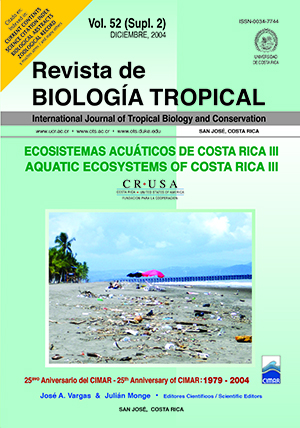Resumen
Este articulo describe una investigación sobre las concentraciones de bifenilos policlorados (PCB) en cuatro regiones geográficas (tres en el Pacífico y una en el Caribe) costeras de Costa Rica.: Bahía Culebra, Golfo Dulce, Golfo de Nicoya, y Limón. Las concentraciones totales de PCB fueron bajas en todas las regiones excepto en el puerto de Golfito (Golfo Dulce). Las concentraciones promedio fueron de 2.80 ng /g dw, con una desviación estándar de 2.75. Las bajas concentraciones pueden estar asociadas a: la ausencia de contaminación por PCB, la degradación posterior en éste clima cálido, o la poca capacidad de absorción de los sedimentos.Citas
Broman, D., C. Naf & Y. Zebühr. 1992. Occurrence and dynamics of polychlorinated dibenzo-p-dioxins and dibenzofurans and other combustion related organic pollutants in the aquatic environment of the Baltic. Chemosphere 25: 125-128.
Dannenberger, D., R. Andersson & C. Rappe. 1997. Levels and patterns of polchlorinated dibenzo-p-dioxins, dibenzofurans and biphenyls in surface sediments from the Western Baltic Sea (Arkona Basin) and the Oder River estuarine system. Mar. Poll. Bull. 38: 1016-1024.
Foreman, W.T., B.F. Connor, E.T. Furlong, D.G. Vaught & L.M. Merten. 1995. Methods of analysis by the U.S. Geological Survey National Water Quality Laboratory – determination of organochlorine pesticides and polychlorinated biphenyls in bottom sediment by dual capillary-column gas chromatography with electron-dapture detection. USGS Open-File Report 95-140. 78p.
Grimalt, J. O.; B. L. van Drooge, A. Ribes, R. Vilanova, P. Fernandez & P. Appleby. 2004. Persistent organochlorine compounds in soils and sediments of European high altitude mountain lakes. Chemosphere 54. 1549-1561.
Jiménez, C. 2001. Seawater temperature measured at the surface and at two depths (7 and 12 m) in one coral reef at Culebra Bay, Gulf of Papagayo, Costa Rica. Rev. Biol. Trop. 49: 153-161.
Lee, K.T., S. Tanage & C. Koh. 2001: Contamination of polyshlorinated biphenyls (PCBs) in sediments from Kyeonggi Bay and nearby areas, Korea. Mar. Poll. Bull. 42: 273-279.
Loganathan, B.G., K.N. Irvine, K. Kannan, V. Pragatheeswaran & K.S. Sajwan. 1997. Distribution of selected PCB congeners in the Babcock Street Sewer District: a multimedia approach to identify PCB sources in combined sewer overflows (CSOs) discharging to the Buffalo River, New York. Arch. Environ. Contam. Toxicol. 33: 130-40.
Rappe, C. 1993. Environmental concentrations and ecotoxicological effects of PCDDs, PCDFs, and related compounds. DIOXIN 93, Organohalogen Compounds 12: 163-170.
Spongberg, A.L. & P. Davis. 1999. Preliminary investigation of pesticide contamination in Golfo Dulce, Costa Rica. Rev. Biol. Trop. 46 (Suppl.5): 111-124.
Vanier, C., M. Sylvestre & D. Planas. 1996. Persistence and fate of PCBs in sediments of the Saint Lawrence River. The Science of the Total Environment 192: 229-244.
Vargas, J.A. 1995: The Gulf of Nicoya estuary, Costa Rica: past, present, and future cooperative research. Helgoländer Meeresunters 49: 821-828.
Wang, H., J.A. Kostel, A.L. St. Amand & K.A. Gray. 1999. 2: The response of a laboratory stream system to PCB exposure: study of periphytic and sediment accumulation patterns. Water Res. 33: 3749-3761.
Comentarios

Esta obra está bajo una licencia internacional Creative Commons Atribución 4.0.
Derechos de autor 2004 Revista de Biología Tropical


